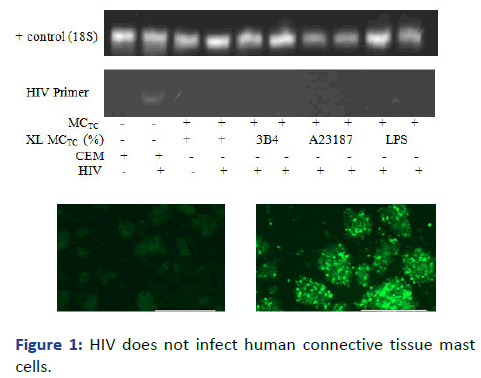Short Communication - (2024) Volume 10, Issue 3
Primary Human Connective Tissue Mast Cells are Not a Reservoir for HIV
Dellinger K1,
Duncan B2 and
Chris Kepley2*
1Department of Nanoengineering, University of North Carolina, North Carolina, USA
2Department of Nanoscience, University of North Carolina, North Carolina, USA
*Correspondence:
Chris Kepley, Department of Nanoscience, University of North Carolina, North Carolina,
USA,
Email:
Received: 07-Aug-2020, Manuscript No. IPJHRV-24-5858;
Editor assigned: 12-Aug-2020, Pre QC No. IPJHRV-24-5858 (PQ);
Reviewed: 26-Aug-2020, QC No. IPJHRV-24-5858;
Revised: 01-Jul-2024, Manuscript No. IPJHRV-24-5858 (R);
Published:
29-Jul-2024, DOI: 10.21767/2471-9676.10.3.21
Introduction
Human Immunodeficiency Virus (HIV) is the virus that causes
Acquired Immune Deficiency Syndrome (AIDS). While Highly
Active Anti-Retroviral Treatment (HAART) medications have
been efficacious in suppressing viral replication, once it is
discontinued virus emerges from cellular reservoirs [1].
However, it is not clear what cell types the virus uses as latent
cellular reservoirs. Identifying the cellular reservoir in which
HIV invades and eludes the immune system is of the utmost
importance as this will facilitate new strategies to potentially
target and kill those infected cells [2].
Description
Mast cells are ubiquitously expressed cells residing in
tissue and mast cell progenitors can be infected with HIV,
which can lead to a latent reservoir in tissue in humans
[3]. Other studies using mast cell-like cell lines or mast
cells derived from progenitor cells in the blood can be
infected. Most recently, mast cells from gastrointestinal
mucosa were shown to be susceptible to HIV infection while
other studies found no evidence of active replication in
mast cells.
To our knowledge no studies have examined if human
Connective Tissue Mast Cells (MCTC) serve as a reservoir for
HIV vial latency [4]. Given that MCTC mast cells are one of the
first immune cells that HIV encounters in vivo, we
hypothesized they could be infected by HIV following FcεRI or
non-FcεRI receptor dependent challenge with various
secretagogues and serve as a latent reservoir for HIV.
To test this hypothesis MCTC with or without FcεRI-and non-
FcεRI stimulation were challenged with live HIV up to five
days. As seen in Figure 1, MCTC did not become infected with
HIV under resting or any stimulated conditions as assessed by
PCR of the HIV-specific marker p24. As a control CEM-GFP
cells were actively infected as assessed by p24 expression and
GFP upregulation (Figure 1) [5]. As expected no viral proteins
were detected in the mast cell lysate using western blotting
(not shown). This study suggests HIV does not infect human
MCTC or the progenitors that give rise to them and therefore
do not serve as a reservoir for HIV [6].

Figure 1: HIV does not infect human connective tissue mast
cells.
MCTC were plated in duplicate in a 24 well plate (5 × 105 cells/
well) with (XL) or without various FcεRI-dependent (anti-
FcεRI-alpha receptor antibody 3B4) or non- FcεRIdependent stimuli calcium ionophore (A23187, 0.1 μg/
mL) or lipopolysaccharide (LPS; 1.5 μg/ml) overnight [7]. The
average percent degranulation is given. The following day live
HIVLAI (NIH AIDS Reagent Program, Germantown, MD) was
added to each well at a multiplicity of infection between 0.1
and 0.5 and incubated for 5 days. After 5 days cells were
washed three times and left to incubate overnight in new,
virus-free media to allow for any non-internalized virus to
either infect or be released from non-specific adhesion to
cellular plasma membranes [8]. After a final wash, cells were
suspended in water for subsequent PCR preparation. For
detection of viral DNA by PCR, the primers used were: Alu
FWD: 5’-GCC TCA ATA AAG CTT GCC TTG A-3’ and gag REV: 5’-
CAT CTC TCT CCT TCT AGC CTC-3‘.
Conclusion
DNA gels (A) shows HIV DNA amplicon (275bp) and 18s
control primers (129bp). Experiments were repeated three
times from normal donors. As a control virus was added to
the CEM-GFP cell line (NIH AIDS Reagent Program,
Germantown, MD) and viral uptake monitored by GFP.
Representative CEM-GFP pictures above are: B: Uninfected; C:
Infected. Scale bar represents 400 μm.
References
- Pierson T, McArthur J, Siliciano RF (2000) Reservoirs for HIV-1: Mechanisms for viral persistence in the presence of antiviral immune responses and antiretroviral therapy. Annu Rev Immunol. 18(1):665-708.
[Crossref] [Google Scholar] [PubMed]
- Alexaki A, Liu Y, Wigdahl B (2008) Cellular reservoirs of HIV-1 and their role in viral persistence. Curr HIV Res. 6(5):388-400.
[Crossref] [Google Scholar] [PubMed]
- Chatzidimitriou D, Tsotridou E, Grigoropoulos P, Skoura L (2020) HIV-1: Towards understanding the nature and quantifying the latent reservoir. Acta Virol. 64(1).
[Crossref] [Google Scholar] [PubMed]
- McNamara LA, Collins KL (2011) Hematopoietic stem/precursor cells as HIV reservoirs. Curr Opin HIV AIDS. 6(1):43-48.
[Crossref] [Google Scholar] [PubMed]
- Taub DD, Mikovits JA, Nilsson G, Schaffer EM, Key ML, et al. (2004) Alterations in mast cell function and survival following in vitro infection with human immunodeficiency viruses-1 through CXCR4. Cell Immunol. 230(2):65-80.
[Crossref] [Google Scholar] [PubMed]
- Chelucci C, Hassan HJ, Locardi C, Bulgarini D, Pelosi E, et al. (1995) In vitro human immunodeficiency virus-1 infection of purified hematopoietic progenitors in single-cell culture. Blood. 85(5):1181-1187.
[Crossref] [Google Scholar] [PubMed]
- Sundstrom JB, Ellis JE, Hair GA, Kirshenbaum AS, Metcalfe DD, et al. (2007) Human tissue mast cells are an inducible reservoir of persistent HIV infection. Blood J Am Soc Hematol. 109(12):5293-5300.
[Crossref] [Google Scholar] [PubMed]
- Jiang AP, Jiang JF, Wei JF, Guo MG, Qin Y, et al. (2016) Human mucosal mast cells capture HIV-1 and mediate viral trans-infection of CD4+ T cells. J Virol. 90(6):2928-2937.
[Crossref] [Google Scholar] [PubMed]
Citation: Dellinger K, Duncan B, Kepley C (2024) Primary Human Connective Tissue Mast Cells are Not a Reservoir for HIV.
J HIV Retro virus.10:11
Copyright: © 2024 Dellinger K, et al. This is an open-access article distributed under the terms of the Creative
Commons Attribution License, which permits unrestricted use, distribution, and reproduction in any medium, provided the
original author and source are credited.


